Nothing stirs up the internet rumour mill quite like the speculation around a new generation of graphics cards, and Nvidia’s next generation GPU architecture, Blackwell, is currently the source of much debate in the PC hardware world.
Current rumours suggest that Nvidia will be announcing the RTX 5090, RTX 5080 and RTX 5070 at CES 2025, although as with all the rumours and speculation we’ve collected on this page, take that with an appropriate dose of salt. We’ll be updating this page as soon as official info comes in, but for now it’s a collection of the latest scuttlebutt for your perusal.
While we have little official information about Blackwell gaming GPUs so far, we have had an announcement regarding Blackwell enterprise GPUs, the B100 and B200. These dual-GPU monsters are designed for AI processing, with a total of 208 billion transistors to the previous 80 billion transistors in the Hopper H200 and H100 GPUs. How many of the features and architectural changes in these new enterprise GPUs make it over to gaming GPUs, however, remains to be seen. One of the big questions is whether Nvidia uses its dual-die technology from those new AI chips in Blackwell gaming GPUs.
It seems like it wasn’t that long ago we were sorting through the rumoured specs of the Ada Lovelace generation of graphics cards, and to be quite honest, it wasn’t. A quick look back to early 2022 finds us speculating on some of the potential power requirements of Nvidia’s next generation flagship, the card that eventually turned out to be the RTX 4090, and a possible max TDP of 800W or more.
Thankfully when the RTX 4090 did eventually arrive it wasn’t even close to that level of power draw, but with a TGP of 450W it was still surprisingly thirsty. A handy reminder then, that while speculation of this type can (and often does) end up being off the mark, a grain of truth can often be found.
Nvidia still remains typically tight-lipped about it’s next-gen gaming GPUs, however, although given what we have so far, it’s still possible to gain a decent idea as to where it might be heading with the next generation of cards.
So what can we expect, and what do we want in the next generation of Nvidia GPUs?
Nvidia Blackwell naming scheme
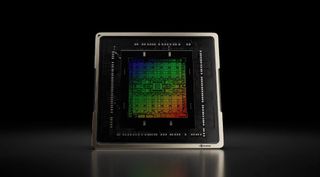
What naming scheme can we expect for Nvidia Blackwell?
The previous Nvidia graphics processor generation was named Ada Lovelace, after the English mathematician and writer who worked extensively on Charles Babbage’s mechanical computer, the Analytical Engine. This new generation of processors is to be named “Blackwell” after David Blackwell, an American mathematician who made significant contributions to game theory, probability theory, information theory and statistics.
The RTX 4090 was based on the Ada Lovelace AD102 graphics processor, and was later followed by the RTX 4080, based on the AD103, and the RTX 4070 based on the AD104, before being followed by the RTX 4060 and RTX 4060 Ti variations using AD107 and AD106 respectively.
According to known Nvidia leaker kopite7kimi, the new generation of GPUs will use the GB prefix, and will reportedly be led by the GB202 as presumably the flagship card, then followed by the GB203, GB205 and GB206, with the entry level card being the GB207, much like the RTX 4060 with its AD107 designation.
| Ampere | Ada Lovelace | Blackwell* |
|---|---|---|
| GA102 | AD102 | GB202 |
| Row 1 – Cell 0 | AD103 | GB203 |
| GA104 | AD104 | Row 2 – Cell 2 |
| Row 3 – Cell 0 | Row 3 – Cell 1 | GB205 |
| GA106 | AD106 | GB206 |
| GA107 | AD107 | GB207 |
| Row 6 – Cell 0 | Row 6 – Cell 1 | * rumoured name |
Given the announcements made around the B100 and B200 enterprise GPUs, it seems that these GB codenames might create something of a confusing naming scheme if true. Nvidia refers to CPU and GPU superchips and superchip systems under a GB fronted moniker i.e. GB200, for “Grace Blackwell”, while the rumours still stand that GB202 etc will be the codename for consumer graphics cards.
Even though the expected release is now somewhat close, there’s still plenty of time for model numbers to change and the rumours to be disproven before we see the consumer GPUs announced officially.
It is worth noting that in recent history Nvidia has sometimes disaggregated its enterprise, compute-focused architecture from its gaming GPUs. We’ve never seen either the Volta or Hopper architectures used in consumer graphics cards, though it did use both Pascal and Ampere architectures in enterprise.
If the rumoured GB naming scheme for consumer GPUs is accurate, the surprise here would be the move away from the 04 designation, with its presumed replacement being the 05. Although whether that’s how things end up stacking in terms of the eventual product line up is still to be confirmed. Nvidia currently lines up its GPUs by performance and not by the chip, so whether we’ll see some changes in the last two digits of the product names to reflect this is still unclear, but seems unlikely.
Regardless, we expect that what we’ll end up seeing on the shelves is likely to be called the RTX 50-series, given the steady one-digit increase in the first number of Nvidia GPU product generations previous, i.e. the RTX 30-series to 40-series, and that the tried and tested -080, -070 and -060 designations will be used once again.
After all, if it ‘aint broke don’t fix it, although it’s not like that’s ever stopped anyone’s marketing departments before…
Nvidia Blackwell architecture
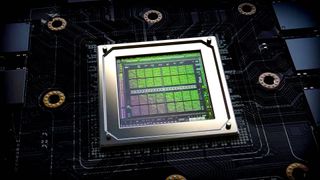
What architectural changes can we expect with Nvidia Blackwell?
Some speculation has surrounded the possibility that Blackwell may use a chiplet-based multi-chip module (MCM) as opposed to a monolithic design. We now know for sure that Nvidia has gone multi-die for its new AI GPUs.
AMD already makes use of a chiplet-based design in its RDNA 3 series of GPUs, although this is based around using separate compute, I/O and memory dies, not multiple compute dies themselves. Nvidia has so far stuck to monolithic architectures for gaming, but a shift towards a chiplet design would make sense in terms of of maximising yields in the long run, as the AD102 die in the RTX 4090 is a rather hefty 609mm², whereas the GCD used in AMD’s Navi 31 is around half that.
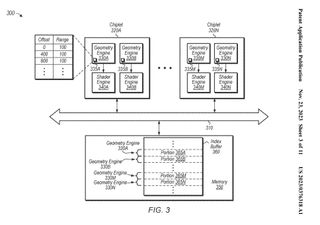
Cutting down die sizes would make sense in terms of maximising manufacturing output, and also in terms of GPU packaging. Although AMD seems to have jumped ahead of the game architecturally, if not in terms of actual performance, Nvidia is very likely to have chiplet designs of its own up its sleeve.
The Blackwell B100 and B200 enterprise GPUs make use of a dual-GPU Blackwell chip, and while we’d like to see Nvidia’s take on chiplets when it comes to gaming GPUs, whether we see them used in this upcoming generation remains to be seen. If I had to guess I would suggest that it’s probably at least a generation too soon for Nvidia to make that shift over to a chiplet design.
Putting aside chiplets for a second, one thing we’re likely to see in a future Geforce GPU is some new fifth-generation Tensor Cores. We first learned of these in the announcement for the Nvidia B100 and B200 AI-processing GPUs, and given that fourth-generation Tensor Cores made the leap from enterprise GPUs into the RTX 40-series, it seems likely they’ll do the same here.
Another likely contender to come over from the enterprise models is the porting over of the Decompression Engine. This accelerates GDeflate, and its adoption in consumer hardware would fit with the attempts made in previous developments to GPU decompression like RTX IO. The faster a GPU can decompress assets then the faster they can be loaded, enabling more detailed and faster loading game worlds with potentially higher performance overall.
The B100 and B200 are dual-GPU chips, and while that makes a lot of sense for enterprise usage it doesn’t necessarily mean we’ll see the same sort of architectural design in consumer graphics cards, although it’s far from impossible. Getting two GPUs to run together as one for gaming purposes is a big ask, although the possibility of this happening in future is a tantalising prospect.
Nvidia Blackwell process technology
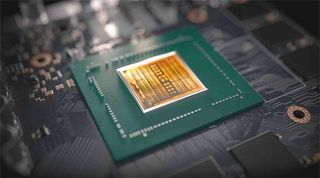
What process will Nvidia Blackwell use?
Rumours initially indicated (via Extreme Tech) that Blackwell would be adopting TSMC’s 3nm process node, which, given that the current generation of cards are on the 5nm process, would make sense as a logical progression.
The Blackwell enterprise GPUs, however, are made on TSMC’s 4NP process node. This is reportedly an extension of the custom 4N process node, and is more closely related to TSMC’s 5nm node.
While we still don’t know which node the new consumer GPUs will be based upon, it seems much more likely that the new cards will follow in the footsteps of the enterprise models. That’ll be 4NP then, if we had to make a bet.
Nvidia Blackwell GB202
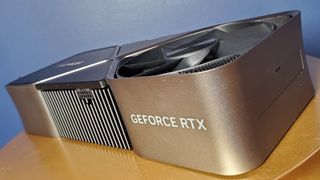
GB202: The RTX 5090… probably
Hardware leaker kopite7kimi previously suggested that GB202—or what we’re presuming is the RTX 5090—would come with a 512-bit bus, but later changed this prediction to 384-bit instead.
However, since then they’ve appeared to change their mind, as their most recent tweet on the subject suggests a 512-bit bus once more.
Kopite7kimi has also claimed that the new series will use GDDR7 28Gbps memory, which—while not at the top end of the spec—would still be a significant upgrade over regular GDDR6X.
In terms of core counts, rumours vary. According to a now-deleted post on Chiphell (via Guru3d), GB202 was rumoured to include 192 SMs with a possible 24,576 CUDA cores, alongside 192 Ray Tracing cores and 768 Tensor cores.
Just to keep you up to speed, the RTX 4090 makes use of 128 SMs, 16,384 CUDA cores, 128 Ray Tracing cores and 512 Tensor cores.
The latest rumours say that the RTX 5090 will feature 21,760 CUDA cores, and a 600 W peak power requirement. That’s a significant uplift over the 450 W peak power requirement of the RTX 4090, and suggests that the new cards in general will have significantly higher power demands than the current generation.
If the specifications above turn out to be correct, then the RTX 5090 would likely deliver a very substantial performance uplift over the RTX 4090, a card that itself remains head and shoulders ahead of every other gaming GPU currently available today.
Ultimately, given Nvidia’s dominance at the very top of the stack thanks to the success of the RTX 4090, we’d expect the next generation top of the range card to also swing for the fences when it comes to keeping up that performance gap.
While AMD has had some decent mid-range releases in the form of the RX 7800 XT and RX 7700 XT, when it comes to even its highest end card, the RX 7900 XTX, it has remained outpaced. Now that AMD has announced that it won’t be aiming for the high-end market with its RDNA 4 cards, Nvidia has plenty of breathing room to do what it likes with its top end GPU, although these reported specs would suggest that it’s still aiming for maximum performance.
Nvidia Blackwell: the rest of the family

The RTX 5080, RTX 5070 and RTX 5060… also probably
While most of the speculation and leaks so far revolve around the top-end chip, much like the current generation it’s the mid-range to upper mid-range of the market where the biggest battles are likely to be fought.
Contrary to more recent Nvidia GPU launches, the rumours say that the RTX 5070 may well launch alongside the RTX 5090 and RTX 5080. That’d be a little bit of a shake up in relation to the traditional launch line up, but would mean we’d get an ultra high-end, a high-end, and a mid-range GPU revealed all at once.
In terms of the RTX 5080, kopite7kimi has been busy spilling the speculative beans again. They’ve tweeted specs including a 400 W peak power limit (compared to the RTX 4080’s 320 W), 10,752 CUDA cores, 16 GB of GDDR7, and a 256-bit bus.
That’s caused a little bit of grumbling in response, as those specs, while impressive, wouldn’t put it close to the RTX 4090 in terms of performance—on paper, at least. It’d be something of a reasonable upgrade on the RTX 4080 and RTX 4080 Super, but these rumours haven’t exactly set the world alight with excitement for a card with these sorts of numbers.
That being said, the RTX 4080 GPUs are impressive to begin with, so a decent uplift in performance wouldn’t exactly make for a slow high-end card for the Blackwell generation.
Speaking of internet grumblings, the rumoured specs for the RTX 5070 have caused some discontent of their own. Wccftech has reported that the card will make use of 12 GB GDDR7 VRAM, which is the same amount as the previous gen RTX 4070. VRAM can be a touchy issue for some, as many have complained that this may be a cynical move to force 4K gamers to buy the more expensive, high-end models for the best performance.
Nvidia has already released a post about the current gen 40-series cards and VRAM requirements, essentially saying that L1 and L2 cache is more important to performance than the RAM loadout. This was in response to complaints about the 8 GB RTX 4060 Ti, with Nvidia eventually capitulating and releasing a 16 GB version of the card that performed virtually identically.
Speaking of the RTX 4060 Ti, what about the presumed RTX 5060? There’s not been a lot of talk yet about this GPU (presuming we get one at all), but it’d be reasonable to assume that it’d be aiming for RTX 4070-like performance at a lower price point. That’s pure speculation, however, so we’ll have to wait and see what the bottom end of the stack might look like when it eventually arrives.
Nvidia Blackwell pricing
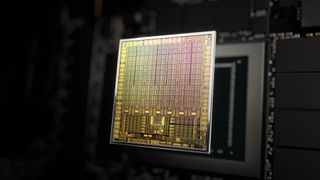
Will we see any sort of price correction on Nvidia Blackwell GPUs?
And so we reach the million dollar question: What sort of pricing are we expecting for these new GPUs?
Well, given that Nvidia has shown no real inclination thus far to adjust its pricing back to pre-pandemic levels, looking at the launch prices of the current cards strikes as a reasonable metric to start basing our guesses for the price points of the next generation too.
| Nvidia GPU | Launch date | MSRP at launch |
|---|---|---|
| RTX 4090 | 12/10/22 | $1,599 |
| RTX 4080 Super | 31/01/24 | $999 |
| RTX 4080 | 16/11/22 | $1,199 |
| RTX 4070 Ti Super | 24/01/24 | $799 |
| RTX 4070 Ti | 05/01/23 | $799 |
| RTX 4070 Super | 17/01/24 | $599 |
| RTX 4070 | 13/04/23 | $599 |
| RTX 4060 Ti (16GB) | 18/07/23 | $499 |
| RTX 4060 Ti (8GB) | 24/05/23 | $399 |
| RTX 4060 | 29/06/23 | $299 |
However, it is worth noting that some small adjustments have been made to its pricing strategy for some of its more recent cards, like the $50 price drop for the RTX 4070 in response to the AMD RX 7800 XT, or the $999 price tag for the RTX 4080 Super in comparison to the $1,200 original model.
While it’s unlikely that Nvidia feels any pressure from AMD at this point, it’s possible that the mid-range might be a place where it wants to compete with the latter’s RDNA 4 chips.
The RTX 5090 is rumoured to be a similar price to the RTX 4090, with no “significant increase”. What significant means in this instance is difficult to say, but we’d expect to see something like a $100-$200 increase, making it a $1,700-$1,800 card.
While some have speculated over a potential $2,000 price tag, Nvidia has previously tried shipping a top-end card for this figure in the RTX 3090 Ti, before rowing back on the pricing. Lessons may well have been learned here, so anything $2,000 or up seems unlikely.
As for the RTX 5080? It’d make a lot of sense for Nvidia to stick to the $999 price point of the RTX 4080 Super, which was very well-received for its identical performance to the non-Super variant for $200 less.
And the RTX 5070? There’s no word on pricing even from the rumour mill at this point, but a likely bet would be that it’d be just a touch more expensive than the launch price of the RTX 4070 at $599. $649 seems about right if we had to guess, but time will tell, of course.
At the very least, any huge price drops in comparison to the current models seem very unlikely, especially given Nvidia CEO Jensen Huang’s comments on the pricing of the generation previous.
